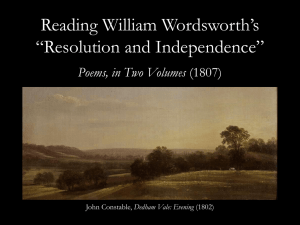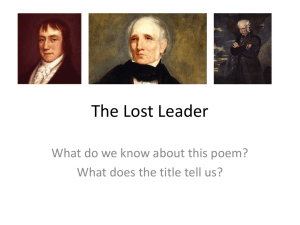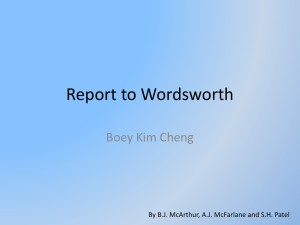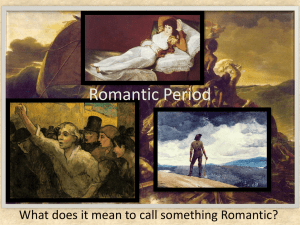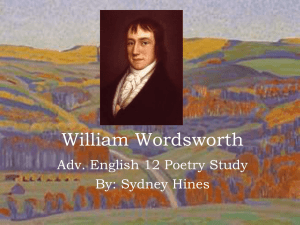ROMANTICISM (Period 1) - MHS AP Literature 2012
advertisement
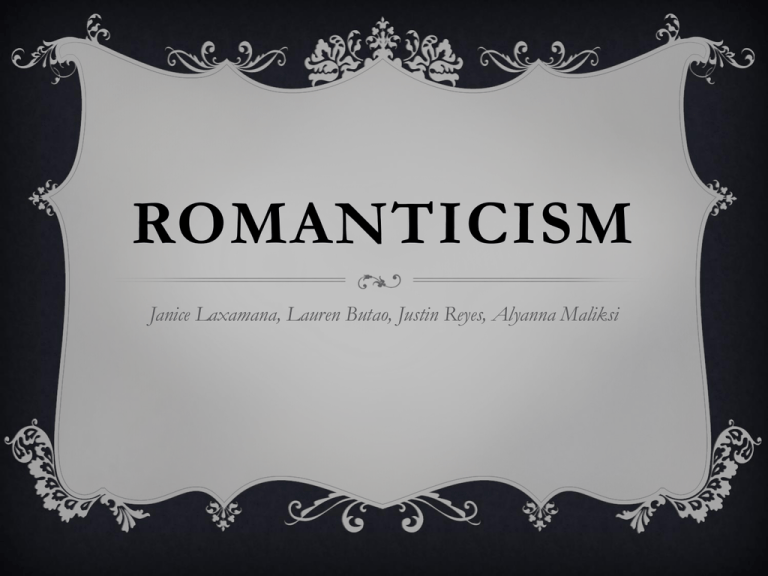
ROMANTICISM Janice Laxamana, Lauren Butao, Justin Reyes, Alyanna Maliksi ROMANTICISM Romanticism is an emotional response to the Neoclassical Era • Neoclassical is revival of a classical style (in art or literature , architecture, music) but from a new perspective or with a new motivation • While the neoclassical era had strict laws of balance and restraint, the Romantic era moved away from that by allowing artistic freedom, experimentation, and creativity It rejected the order and restrictions of neoclassicism in favor of individual freedom of expression and greater emphasis on feeling – not only love , but intense emotions such as hate, depression, pain, etc. It emphasizes both nature and human imagination; Intuition over reason Favored more natural, emotional and personal artistic themes THEMES AND TECHNIQUES Emotion Involves subjects such as death, love, hate, despair, or dream. Conflict Conveys a sense drama or tragedy Ex: life – death , love –hate , dream – vision. Exoticism Conveys a sense of strangeness Irony Emphasizes message of the poem Imagery Illustrates the emotional setting and situation of a poem Allusions Reference to exotic history or culture, such as Greece. Tone shift + Paradox Emphasizes emotional message Metaphors, Similes, comparisons. Emphasizes imagery or emotion Personification WALT WHITMAN Lived from May 31, 1819 to March 26, 1892. Second son of Walter Whitman. Family consisted of nine children. Lived in Brooklyn and Long Island. American poet, essayist, journalist. Worked as a journalist, teacher, government clerk & in addition to publishing poetry was a volunteer nurse during American Civil War. Often called “father of free verse”. Founded a weekly newspaper, Long-Islander. NOTABLE WORKS Franklin Evans (1842) Leaves of Grass (1855) Drum-Taps (1865) Memoranda During the War Democratic Vistas (1871) A NOISELESS PATIENT SPIDER (1871) A noiseless patient spider, I mark’d where on a little promontory it stood, isolated, Mark’d how to explore the vacant vast surrounding, It launch’d forth filament, filament, filament out of itself, Ever unreeling them, ever tirelessly speeding them. And you O my soul where you stand, Surrounded, detached, in measureless oceans of space, Ceaselessly musing, venturing, throwing, seeking the spheres to connect them, Till the bridge you will need be form’d, till the ductile anchor hold, Till the gossamer thread you fling catch somewhere, O my Soul. ANALY SIS Alliteration: “vacant vast surrounding” “It launch’d forth filament, filament, filament, out of itself ” Personification: “O my soul where you stand” Apostrophe: Soul Tone: Dark, lonely POV Shift: From spider to soul. Theme: Hopelessness Metaphor: Comparing a spider to a human. • The spider is trying to find something to build and connect a web and the human/soul is trying to build connections to the world to find a place in the universe. How it fits into movement: • • Speaker uses the spider as a symbol of himself. He is emotional and feels lonely/isolated from the world. Connects universe to nature. PERCY BY SSHE SHELLY Lived from 1792-1822 in Horsham, Sussex, England Expelled from Oxford University for his atheistic views and became estranged from his father – his rough times was where his controversial philosophical and works developed Shelley found friendship with notable Romanticist poets John Keats and Lord George Gordon Byron, and was influenced by William Wordsworth Percy and Byron inspired Mary Shelly for her most famous novel Frankenstein, which Percy wrote the introduction for. He died in one of his sailing ventures at age 29 NOTABLE WORKS Queen Mab: A Philosophical Poem (1813) Ozymandias (1818) Masque of Anarchy (1819) Ode to the West Wind (1820) Note: Shelley often attracted criticism and controversy for his outspoken challenges to oppression, religion, and convention LOVES PHILOSOPHY (1819) The fountains mingle with the river And the rivers with the Ocean, The winds of Heaven mix for ever With a sweet emotion; Nothing in the world is single; All things by a law divine In one spirit meet and mingle. Why not I with thine? -See the mountains kiss high Heaven And the waves clasp one another; No sister-flower would be forgiven If it disdained its brother; And the sunlight clasps the earth And the moonbeams kiss the sea: What is all this sweet work worth If thou kiss not me? ANALY SIS First Stanza: Shelley uses elements of nature – river , ocean, winds, etc. – puts them in pairs, and depicts their dependence on one another • All the beauty in this world is connected as one and balance each other – same goes for humans & what connects individuals is love • He connects nature and humans by personifying them “fountains mingle with the river” • Everything in this world has a pair and dependence on one another • Humans are dependent creatures who needs these connections with their pair and needs love for survival ‘Nothing in the world is single All things by a law divine In anothers being mingle – why not I with thine” • Therefore, the speaker states he shouldn’t be single – the speaker is unable to find a bond, therefore his Love is unrequited. Second Stanza: Shelley depicts how elements in nature unite • Diction: uses words like “mingle” “clasp” and “kiss” – love needs to be spiritual as well as physically connected • The word "clasp" suggests that the speaker wants to physically join together with his pair / beloved • In order for the speaker to secure and view the love to be real, he must receive a kiss “what are all these kissings Worth, if thou not kiss me? Finding love is perceived natural, but it is actually a very difficult task WILLIAM WORDSWORTH Wordsworth was born on April 7, 1770 in Cockermouth, Cumbia, England. He attended Hawkshead Grammer School, where his love of poetry was established. Studied at St. John's College in Cambridge, but before his final semester he decided to tour around Europe, an experience that has enhanced his poetic and political sensibilities. During his tour, he came into contact with the French Revolution, this experience brought about Wordsworth interest in the life, troubles, and speech of the "common man". Wordsworth’s most famous poem is the Prelude(1850), it is considered to be the crowning achievement of English romanticism. NOTABLE WORKS The Prelude(1850) An Evening Walk(1793) Descriptive Sketches(1793) Borders(1795) ANALY SIS The poem is apostrophe, Wordsworth is speaking to someone who isn't there. He personifies a plant with love "Is thy love a plant of such weak fibre that the treacherous air of absence withers what was once so fair?" -instead of growing like plants do their love is withering away. "Be left more desolate, more dreary cold than a forsaken birds-nest fill'd with snow" -He uses a simile to compare the feeling of being neglected to an abandoned birds-nest. He talks about how he is vigilant and bound service When a bird abandons their nest the eggs will die Also words like cold and snow symbolize death = passion/love is dying At the end he says "Speak, that my torturing doubts their end may know." He wants them to speak and let him know if his doubts have been true. During the movement there was a heightened interest in nature and in this poem Wordsworth relates his feelings to nature. He is addressing his peers who aren't returning his feelings and is unsure of what to do. Wordsworth questions why they are silent and why there is no return in affection. SPEAK! (1800) WHY art thou silent! Is thy love a plant Of such weak fibre that the treacherous air Of absence withers what was once so fair? Is there no debt to pay, no boon to grant? Yet have my thoughts for thee been vigilant-Bound to thy service with unceasing care, The mind's least generous wish a mendicant For naught but what thy happiness could spare. Speak -- though this soft warm heart, once free to hold A thousand tender pleasures, thine and mine, Be left more desolate, more dreary cold Than a forsaken bird's-nest fill'd with snow 'Mid its own bush of leafless eglantine-Speak, that my torturing doubts their end may know. JOHN KEATS 1795-1821 Five siblings, Two parents. His father died in an accident, and his mother died of Tuberculosis, a common disease in the Romantic era. Intended to become a medic After officially becoming a published poet, he disposed of all his older poems. Diagnosed with Tuberculosis, unable to associate with his loved one, Fanny Brawne Passed away at the age of 25 His experiences in life can be seen in his poetry. NOTABLE WORKS 1818 -Endymion: A Poetic Romance 1819 -Ode to. . . a Psyche, on a Grecian Urn, a Nightingale, Indolence, Melancholy -The Fall of Hyperion (incomplete) -(Drama) - Otho the Great 1820 -Lamia A DRAUGHT OF SUNSHINE (1818) Hence Burgundy, Claret, and Port, Away with old Hock and madeira, Too earthly ye are for my sport; There's a beverage brighter and clearer. Instead of a piriful rummer, My wine overbrims a whole summer; My bowl is the sky, And I drink at my eye, Till I feel in the brain A Delphian pain Then follow, my Caius! then follow: On the green of the hill We will drink our fill Of golden sunshine, Till our brains intertwine With the glory and grace of Apollo! God of the Meridian, And of the East and West, To thee my soul is flown, And my body is earthward press'd. ANALY SIS (1) Begins as happy, sunshine. Sunshine is a metaphor for alcohol. Alcohol makes pain go away Many of allusions to Greek mythology Rhyme scheme starts off s ABAB, then shifts to AABB. Foreshadows the shift in tone, featured in the second half of the poem. Various examples of imagery. ANALY SIS (2) Tone shift, from happy and optimistic, to sad and pessimistic. Take note of the emotion. Simile comparing the author’s life to a mother’s natural instinct to protect her young. Author is suffering from his wants and needs Allusions to Greek mythology Sharp imagery emphasizes emotion of the Romantics. ROMANTICISM QUIZ 1. Romanticism is an emotional response to what era? • • • • A. Neoclassical Era B. Medieval Era C. Renaissance Era D. New Era 2. What types of themes were mainly favored during the romanticism era? • • • • A. Emotional B. Personal Artistic C. Both B&C D. None of these 3. True of False: Romanticism emphasizes both nature and human imagination. 4. Which one of these poems is William Wordsworth’s most famous poem? • A. The Prelude • B. An Evening Walk • C. Descriptive Sketches • D. Borders 5. Who was often called the "father of free verse"? • • • • A. John Keats B. Walt Whitman C. William Wordsworth D. Percy Shelley RESOURCES http://en.wikipedia.org/wiki/Romanticism http://www.poets.org/poet.php/prmPID/126 http://www.poets.org/poet.php/prmPID/66 http://www.poets.org/poet.php/prmPID/179 http://www.poets.org/poet.php/prmPID/296 LESSON Romanticism is an art / literature / poetry movement that emphasizes on individual freedom of expression and feeling – not only love, but hatred, despair, depression, etc. Create a poem / write a paragraph about a situation that evoked intense emotions as the ones listed above. Three brave students that present will receive a prize.

